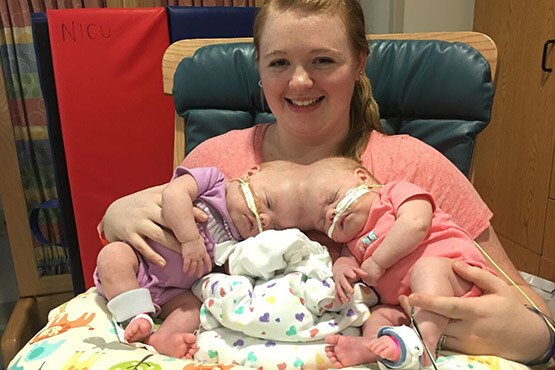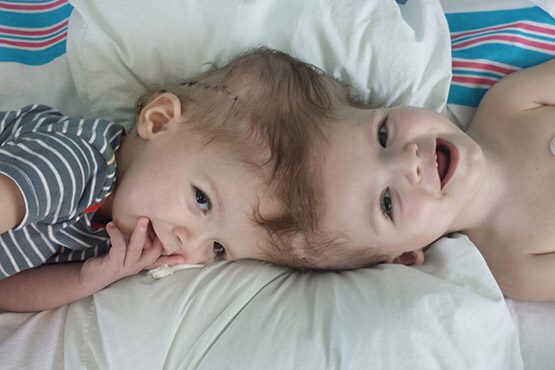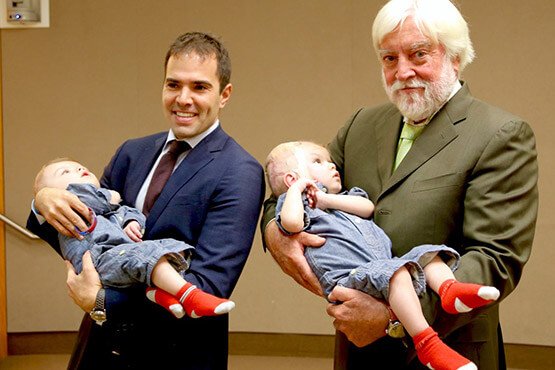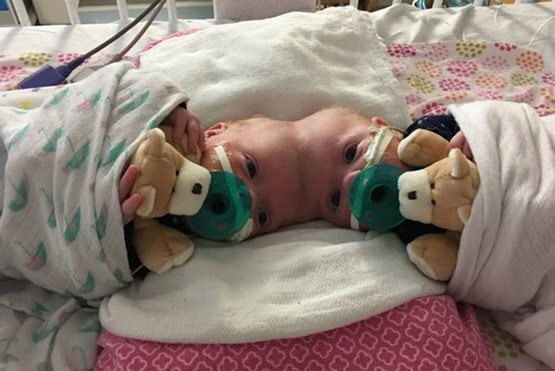At 10 months old, twins Erin and Abby Delaney are no longer fused at the tops of their heads.
But their parents, Heather and Riley, are acutely aware that the hardest part of their medical odyssey is likely ahead. Only time will tell whether the babies’ complex separation surgery at Children’s Hospital of Philadelphia left them with complications that could include neurological damage.
“Both girls had some brain bleeds happen while they were in surgery, Abby significantly more than Erin. So we are waiting to see exactly what that means,” their mother wrote on her blog a week after the procedure. “These days are scary. Yes, the girls got separated, but this is only the beginning.”
Neither the hospital nor the North Carolina couple has granted interviews since their disclosure on Tuesday that the conjoined twins were separated last week. Surgery on “craniopagus” twins, those conjoined at the cranium, has been performed only about 60 times in the world since 1952, and never at CHOP until the Delaney twins.
Although the hospital has released minimal information, Heather Delaney has shared heartfelt, sometimes harrowing, details for more than a year on her blog, “Our Journey with Conjoined Twins Abby & Erin.” She didn’t object to its use for this story.
“Riley and I already love our children more than we could possibly imagine, and that is what makes it so hard,” she wrote in March 2016, shortly after an ultrasound at 11 weeks of pregnancy revealed she was carrying conjoined twins.
“We are choosing to believe that God has a plan for them, and it is to prosper them and give them hope and a future,” added the mother, who closes each post with prayer requests.
‘Ideal’ features
Heather, a former nanny, married Riley, the “love of my life,” in October 2015. They were delighted when she got pregnant three months later. Even though she has younger identical twin sisters, she was surprised when the ultrasound at 11 weeks showed twins.
“I mentioned to the doctor about how they seemed very close,” she wrote on her blog. “That is when … something that was 100 percent joy turned into almost 100 percent terror. He said very abruptly that he thought they might be conjoined.”
Conjoined twins — the result of an embryo that doesn’t completely split into identical twins — occur about once in 200,000 live births. A fraction, perhaps 2 percent, are fused just at the skull.
The extent of that fusion makes all the difference. If more than a little brain tissue is shared, the twins usually die during pregnancy or in the first days after birth.
The ability to surgically separate them “is really a matter of how much is conjoined. That’s the game-changer,” said James T. Goodrich, director of pediatric neurosurgery at Children’s Hospital at Montefiore in New York City.
Goodrich has worked with teams around the world to successfully separate seven sets of craniopagus twins. The most recent case, chronicled by CNN, was in October, when 13-month-old boys Jadon and Anias McDonald were separated at Montefiore.


Although Goodrich didn’t consult on the Delaney twins’ case, he said photos of them showed “ideal” features — connection limited to the top of the skull, both babies looking in the same direction, long foreheads.
But even in best-case scenarios, a critical challenge involves separating the shared cranial blood supply. One twin’s supply is usually dominant, and as blood drains from the heads to the hearts and other organs, the dominant twin becomes a sort of engine, compensating for the weaker twin.
For Clarence and Carl Aguirre, craniopagus twins who came from the Philippines to be separated by Goodrich’s team in 2004, the impact of the imbalance is clear, and was described in news stories about them when they turned 12 in 2014. Clarence, the dominant twin, “uses an iPad, plays video games, and dances to Michael Jackson tunes,” said the Associated Press. Carl “has significant, possibly permanent, problems walking and talking.”
The progress of the McDonald twins, now 21 months old, will be the subject of a CNN update on June 23. Their parents, Nicole and Christian, left their home in Coal City, Ill., to be close to Blythedale Children’s Hospital, a specialty facility in suburban New York where the boys are undergoing rehabilitation.
“We believe that hospital life will not be ending any time soon,” Nicole McDonald wrote on Facebook in February. “When I asked the doctor how long he thought the boys might be here, he commented that he hopes they’ll be here … maybe a year or longer.”
‘Your world stops’
Heather and Riley Delaney contacted CHOP and began biweekly treks to Philadelphia soon after that week-11 ultrasound.
“I have met with lots of doctors, social workers, psychologists, midwives, surgeons, and the list goes on,” Heather blogged. “They make me feel almost normal. To have a place that makes me feel like I’m doing a good job is wonderful.”
At 20 weeks, she moved into the hospital so she could be closely monitored. By then, ultrasounds clearly showed that Erin was the dominant twin, while Abby had signs of insufficient blood flow.
“It has gotten a little worse every time they have scanned,” Heather wrote a year ago.
The babies were delivered by cesarean section the following month, in July, about eight weeks premature.
The infants steadily grew. In late September, they weighed 4 pounds each. In November, they started smiling — a developmental milestone that Heather said “overwhelms me with joy.”
Meanwhile, doctors used 3-D imaging technology to make models and plan the surgery. It would require separating the dura, the protective membrane surrounding the brains, and the shared blood vessels. The riskiest would be a large vein called the sagittal sinus, a channel beneath the brain that allows blood to drain outward from the center of the head.
Doctors explained the implications to Heather.
“Abby would be left with very little [of the sinus], meaning that Abby would have a much harder time and a much greater chance of death,” Heather wrote. “When you are told that sort of information, your world stops.”


Originally, she wrote, doctors planned to separate the vessels in two surgeries, two weeks apart. This multi-stage surgery, which Goodrich helped pioneer and which he advocates, reroutes the shared blood supply more gradually, hopefully reducing complications.
But about six hours into the surgery, “our neurosurgeon came out and explained … they got more than halfway and had no problems. Everything had gone well and the girls were doing so well,” she wrote. “They decided it would be a better idea to continue.”
Ten more hours passed with “very few and very vague updates” before the neurosurgeon again spoke to the parents, telling them Abby had narrowly survived.
“I could see the stress on his face,” Heather wrote. “When they separated the sagittal, Abby started to bleed. They replaced her total blood volume between 10 and 15 times. He said he almost lost her several times but she kept hanging on.”
As often happens in the era of social media, Heather’s blog has not only kept family and friends informed, but has touched strangers. She thanked those who have contributed to their GoFundMe page, which has helped them cover expenses during Riley’s monthlong leave from his job in North Carolina. (She has not mentioned their hometown or his line of work.)
“Keep us in your prayers as the girls get more stable,” she closed her last entry. “Hopefully within the next week or so the girls will be awake and extubated. We still have a long road to go but we’ve made it this far!!!”






